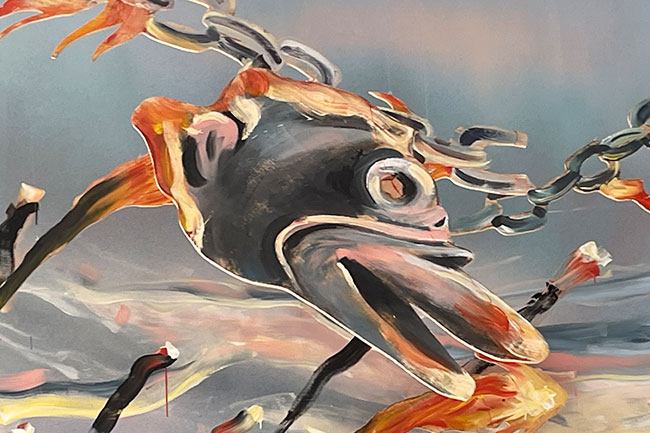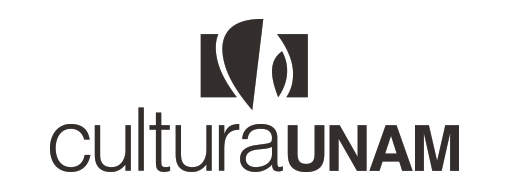El estado de las cosas
Marcos Castro
Punk Nature
We are volcanic. We belong to a city that shares its birthplace with the Xitle volcano, which in Náhuatl means navel —the only scar that remains from our connection to our mothers. A city sprinkled with volcanic rocks in a valley dotted with volcanoes, in a country where the Paricutín, the world's youngest and most broadly registered volcano, was born. In Jorge González Camarena's painting The Eruption of Xitle (1948), we see an indigenous community leaving our foundational volcano behind as it erupts, exiting the frame. As a rule, destruction is followed by creation. The creation of a new space. This space.
Rocks are time in material form. The volcanic rocks of Xitle are the most ancient witnesses of the emergence and growth of what is now Mexico City. These volcanic, rocky, ancient landscapes, now blended with streets, cars, buildings, and the many sounds that comprise our day-to-day, sometimes form images that seem anchored in another reality or another time, or in several times at once. Like Jorge González Camarena imagined the 3rd-century eruption of Xitle in the 1940s, Marcos Castro imagines the eruption of a volcano at the center of everything, not in some remote time, but rather in several times at once: these hybrid times we live in and their speculations.
With enormous talent and imagination, Marcos Castro seeks to narrate these speculations, these hybrid times: the ghost of muralist imagery haunts this exhibition, as does the spirit of urban folksongs by Rockdrigo, the language of emojis, memes, and cornfields. Nopal cactus plants coexist with heavy metal, Aztec figures, Coatlicue, and the punks by nature that are volcanoes in and of themselves. Volcanoes, so far removed from pastoral, docile Nature; each with its own rebellious character. Like that of this particular volcano. In this exhibition, which goes against the grain of The Eruption of Xitle, the indigenous people do not exit the frame. They are not hiding or concealed behind hegemonic discourse as in the past, but emerging from the explosion. Here, they are all named.
The State of Things was completed during the pandemic, amid its uncertainty, keeping the beat of its tempo and rests. Volcanoes destroy, as does the pandemic. This may also be a reminder of the hope that destruction will always be followed by creation. This volcano is a mother, like a navel reminding us that we are volcanic as well. That Nature can also be punk. Leaving docile still life behind, Marcos Castro's artwork cranks up the volume of punk Nature.
Brenda Lozano
Translation: Tanya Huntington
The enhanced reality experience of this project is the product of close collaboration with CENTRO, an institute of higher education dedicated to creative enterprise, and its STEAM Lab, an area focused on generating technological inventiveness for creative industries.
The students and professors of CENTRO acted as consultants in the design and development of enhanced reality experiences, sound design, modelling processes, 3D animation, interface design, and the programming and integration of the graphic proposal for this work.
Synergy Studio, an interdisciplinary firm that specializes in creating synergies between art, creativity, advertising, and technology, contributed technological innovation hand-in-hand with CENTRO. Likewise, a series of accessible filters were developed through social networks on Instagram and Facebook to contribute to the interactive publicity and outreach for this exhibition.
![]()
Marcos Castro (Ciudad de México, 1981)
Estudió la Licenciatura en Artes Visuales en la Escuela Nacional de Pintura, Escultura y Grabado “La Esmeralda”. Ha realizado diversas exposiciones individuales tanto en México como en el extranjero, entre las cuales se encuentran: Te conozco de antes, Proyectos Monclova, Ciudad de México (2021); So It Will Be The Past, Galería Dot Fiftyone, Miami (2020); Mañana, cenizas, Machete Galería (2019); El color del Sur, Machete Galería, Ciudad de México (2017); Objetos necesarios, Galería Dot Fiftyone, Miami (2014); Futuras ruinas, Galería Luis Adelantado, Ciudad de México (2013); Negras tormentas, El Clauselito, Museo de la Ciudad de México, (2012); y Número bestial, Museo Ex Teresa Arte Actual, Ciudad de México (2012), entre otras.
Entre sus exposiciones colectivas destacan: OTRXS MUNDXS, Museo Tamayo, Ciudad de México (2020); 3er Kamias Triennial, Manila, Filipinas (2020); An Exhibition With Works By..., Witte de With Center for Contemporary Art, Rotterdam, Holanda (2020); Estudio de trazo, Museo de Arte Moderno, Ciudad de México (2014); Panorámica, Palacio de Bellas Artes, Ciudad de México (2013); Ruta mística, Museo de Arte Contemporáneo de Monterrey, Monterrey (2013); Historia de A, Museo Amparo, Puebla (2011).
Ha recibido en dos ocasiones la beca Jóvenes Creadores del Fondo Nacional para la Cultura y las Artes (FONCA) en 2007 y 2014. Realizó la residencia Dedazo en 2018, en el Ejido Felipe Carrillo Puerto en Chiapas. En 2014 fue seleccionado ser parte de la residencia Omi, en Nueva York. Participó en 18th Street Arts Center, en Los Ángeles, en 2018; y realizó la residencia Skowhegan, Maine, Estados Unidos en 2016. Actualmente es parte del Sistema Nacional de Creadores de Arte (SNCA) y es socio fundador y codirector del espacio cultural Obrera Centro.
Su obra pertenece a las siguientes colecciones en la Ciudad de México: Colección Fundación JUMEX, Museo de Arte Moderno, Museo Universitario Arte Contemporáneo y Fundación Alumnos 47. En Puebla, en el Museo Amparo, y en Estados Unidos forma parte de las colecciones Perez Art Museum y Patricia Phelps de Cisneros.













